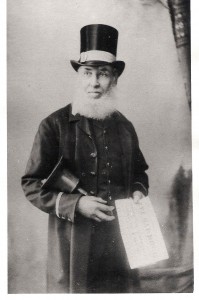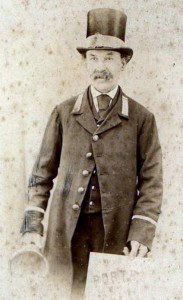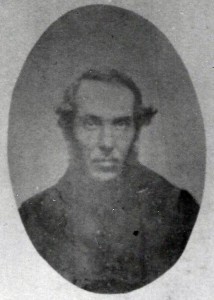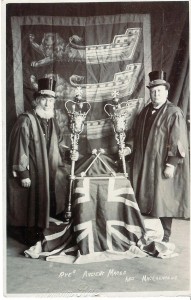AN OLD AND FAITHFUL SERVANT OF THE CORPORATION’
The story of Edwin Hollis Pulford from Ship’s Cook and Shoemaker to Sergeant at Mace and Town Crier of Rye.
By J. C. Pulford.
One day, about 35 years ago, the then Town Crier of Rye, Percy Sherwood, an old acquaintance of my father’s, led my father and me to an upstairs room in the Town Hall to show us an old book that was kept there. In the book was the signature of one of Percy’s Victorian predecessors -Edwin Hollis Pulford.

Although Edwin Pulford was, even then, still remembered as one of Rye’s long-standing Sergeants-at-Mace, Town Criers and Keepers of the Town Hall, he was actually born into a well-established Rye seafaring family. His great-uncle, George Pulford, was the captain of at least two of Rye’s privateer ships in the Seven Years War (1756 -63) and spent much of his life carrying goods by sea between Rye, Exeter and London for merchants such as James Lamb. Many of Edwin’s cousins also worked in the Rye coasting trade in the 18th and 19th centuries as did his father, William, who, in addition, served in Nelson’s navy after falling victim to the press gangs in the Napoleonic Wars. After Edwin’s father returned home from the war he married a 38-year-old widow, Elizabeth Campbell, the daughter of William and Sarah Hollis of Rye.
Edwin was born on the 23rd February 1823, probably in one of the terrace of houses adjoining the Land Gate in Tower Street, which his parents were occupying in 1826 when the property was acquired by a Rye ship-owner William Sharvell. Edwin’s elder brother, John, born in 1817, had not survived his first year and Edwin was to remain the only child from the marriage.
In the 1830s and 40s Edwin’s father was serving in the coal and coasting trade on ships such as the Blue Eyed Lass of Rye and the Brunswick, a 53-ton Rye-built smack. The 1841 census returns record only Edwin and his mother, a school mistress, in their house in Tower Street as William was away on the Commerce taking cargoes to such places as Newcastle, Aberdeen and Sunderland and bringing back coal.

It is not surprising then, that Edwin himself went to sea as ‘1st Boy’, another term for an apprentice. By the age of 24, he is recorded in the registers of the Board of Trade as a merchant seaman, five foot four inches tall with black hair and hazel eyes, who in March 1848 sailed aboard the Anna Louisa, a 161-ton Rye coasting vessel, earning one pound fifteen shillings (£1.75p) a month as a ship’s cook. The ship was employed carrying coals from Hartlepool, Llanelly and Newcastle to Rye and in June sailed from Hartlepool to Cronstadt. His last recorded voyage on the Anna Louisa was in 1849. Both Edwin’s parents died in the Rye Union, his mother in 1847 and his father in 1850. After this, Edwin seems to have given up his life at sea.
Edwin always appears to have lived in Rye, but otherwise his life was anything but settled. Following his early career at sea, his recorded occupations varied from shoemaker or cordwainer, to translator and publican and after his time spent as Sergeant-at-Mace, he continued as a shoemaker and billposter. He had married Rebecca Rhodes in 1845 and in 1851 they were living next door to her parents, James and Harriet, who were fishmongers in Lion Street, by the Red Lion Inn. Rebecca was herself a shrimp seller while her elder sister, Ellen, who lived with her and Edwin, was a milliner and dressmaker. Edwin and Rebecca spent much of the 1860s living in the lower end of the High Street (now The Mint), with, in 1861, their eight-year-old niece, Jane Rhodes, and a house servant, Susannah Moore. By 1862 they had taken over The Dolphin Inn, probably from William Allen, who was the publican there in 1861. The 1867 Post Office Directory then shows Edwin as the publican at The Foresters’ Arms in the High Street indicating that the name of the inn (which seems to be the same building) was changed around that time. In 1871, once again a shoemaker, he and Rebecca were living in Church Square next door to The Jolly Sailor. In October the same year, however, Rebecca died at the age of 46 and was buried in Rye Cemetery.

Early in 1877, during the sixth of Charles Pix Meryon’s nine successive terms as Mayor, Edwin succeeded Thomas Blackman as Sergeant-at-Mace. He was to hold the post, which included duties as Town Crier, Bill Poster and Keeper of the Town Hall, for the next 22 years, serving a total of 16 different mayors including Henry Burra, James Coleman Vidler, John Symonds Vidler and John Neve Masters. During his time in office he, with the second macebearer, Charles Cook, led the robed corporation around the town to commemorate the golden jubilee of Queen Victoria in 1887, saw the formal opening of the road and bridge connecting Rye to East Guldeford by Lord Monkbretton in 1893, the opening of the golf course in 1894 and the building of the Rye and Camber tramway in 1895. With a salary of around £30 per annum, the office of Sergeant-at-Mace did not include provision of a house as it did for his successor, Mr F.W. ‘Billy’ Clark.

Edwin also took on extra responsibilities, for example, enrolling as a special constable on 5th November 1878 for a period of 48 hours to help police the Rye Bonfire parade which had become notorious for its unruly nature at that time.
In 1881 Edwin had been lodging at 12, Watchbell Street with Thomas and Mary Wallace but In 1886, now aged 63, he married again, this time to a 61-year-old widow, Sarah Ransom.
The wedding took place at St John’s Parish Church, Upper Holloway, Islington, on the 14th February. No more is known of this marriage. The census of 1891 records him living alone at 11, Watchbell Street. Edwin’s term of office came to an end in February 1899 , and he spent the rest of his life in his own house, 16, Watchbell Street (now 19). He did not live alone though, for he was joined by his octogenarian cousin, John Chappell Pulford, a retired mariner from Landgate Square and John’s 21-year-old daughter, Elizabeth, who looked after them. Edwin’s health was failing, however, and on May 17th 1902 the Rye Chronicle reported the ‘Death of an Old Official’ who had died the previous Monday (May 12th) although he had been at work in his garden only a fortnight earlier. Edwin was buried in Rye cemetery on the 15th May 1902.It is hard to imagine the changes that Edwin had seen in his lifetime. Born into Georgian England, the age of sail and the coaching inn, by the time he died the age of steam had taken over and the motorcar was making its first appearance on the public roads. From ship’s boy to mayor’s sergeant, Edwin, well-educated and well-read, must have felt so much a part of those changes as he shouldered the mace in civic processions and rang out the news with his bell. The then Mayor of Rye, Alderman Jarrett, said that ‘an old and faithful servant of the corporation had passed away’ and that he had ‘discharged his duties conscientiously and well.’
By J. C. Pulford.
“Rye’s Own” January 2008
All articles, photographs and drawings on this web site are World
Copyright Protected. No reproduction for publication without prior
arrangement.